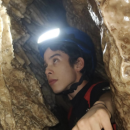Echoes of Identity and Artistry: Why the Museo Casa del Alabado’s Cylinder Seals Haven’t Left My Mind
It’s been years since I spent that transformative summer and fall at the Museo Casa del Alabado in Quito, Ecuador—my hometown—yet I find myself continually drawn back
MORE IN THIS SECTION
It’s been years since I spent that transformative summer and fall at the Museo Casa del Alabado in Quito, Ecuador—my hometown—yet I find myself continually drawn back to those quiet halls filled with pre-Columbian art. There, surrounded by the ancient artifacts of my native land, I discovered a deep and abiding love for a seemingly small and often overlooked object: the cylinder seal.
At first glance, a cylinder seal might not seem like much—just a small, intricately carved piece of stone or ceramic. But these objects, no larger than a cup, are imbued with a profound significance. Cylinder seals in the pre-Columbian world, much like their Mesopotamian counterparts, were more than just tools; they were bearers of identity, storytellers, and protective amulets. They functioned much as a signature does today, marking personal property, sealing doors or containers, and making documents legally binding.
One of the most fascinating aspects of these seals is how they were created. It’s important to note that each seal was carved backwards so that when rolled across clay, the resulting impression would be right-side up. This reversal process speaks to the incredible skill and foresight of the artists who crafted them. When you look at a cylinder seal, you must consider not just the image it produces but also the negative space—the voids that were deliberately left uncarved, which are just as meaningful as the carved sections.
As an undergraduate student at the University of Pennsylvania, I had the honor of taking a couple of Doctor Holly Pitman’s classes on Mesopotamia and the opportunity to examine Mesopotamian cylinder seals up close in the Middle Eastern galleries of the Penn Museum. This experience deepened my appreciation for these ancient objects and highlighted the connections between Mesopotamian and pre-Columbian seals.
It's inevitable to think of the artist when gazing at these treasures that were once everyday tools, essential to daily life. These objects were functional, yet they were also deeply personal and artistic expressions. Are they so fascinating simply because they’re no longer in use? Perhaps. But there’s more to it than just nostalgia.
RELATED CONTENT
The pre-Columbian cylinder seals I encountered at the Museo Casa del Alabado captivated me with their agency and intimacy. These seals, while larger than the Mesopotamian Sumerian seals—some of which are as tiny as a quarter—held just as much power. The Mesopotamian seals, due to their small size, were worn on strings or as amulets, constantly close to their owner. In contrast, the pre-Columbian seals, being much larger, raise the question of whether they too were worn or carried, and how their size influenced their use.
I couldn’t help but draw comparisons between the pre-Columbian seals and the famous Mesopotamian ones, like the seal of Queen Puabi found in her grave. There is something deeply intimate about a personal object that accompanied a person into the afterlife, marking their possessions even in death.
If a cylinder seal is found in a tomb, is it a funeral piece? If it is worn around the neck, is it considered jewelry? If used to sign documents, is it a fancier version of a practical stamp seal? These are questions worth pondering as we continue to explore and understand the multifaceted roles these ancient objects played in their respective cultures.
Cylinder seals, as I see them, are more intimate than jewelry. They hold the weight of their owners' identities, their stories, and their lives. They have a unique agency that extends beyond the person who owned them. In fact, these seals have three viewers: the artist who created them, the owner who used them, and us, the audience, who gaze at them behind museum glass. For a couple of minutes, there is a connection between the owner, the artist, and the viewer—a moment where the past and present meet that I strongly recommend you take part in the next time you visit the Casa del Alabado Museum.





LEAVE A COMMENT: